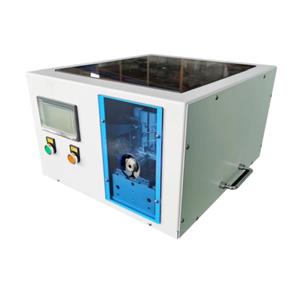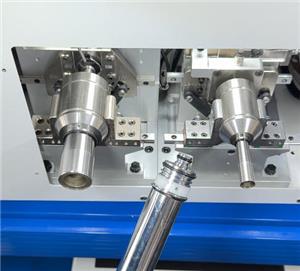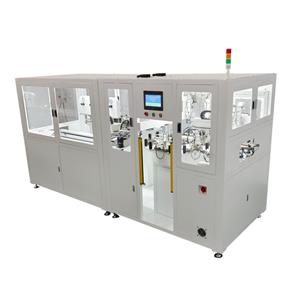Revolutionizing the Winding Industry: A Look at Cutting - Edge Winding Machines
In the ever - evolving world of manufacturing, the winding machine stands as a cornerstone in the production of various electrical and mechanical components. These machines are responsible for precisely winding wires, cables, and other materials onto spools or cores, a process that is crucial for the proper functioning of countless products. Today, we explore two advanced winding machines that are setting new standards in the industry: the Winding machine BSGC - 2 and the Independent pay off and take up rack (FJDL - 1600).
Winding machine BSGC - 2: Dual - Head Efficiency
The Winding machine BSGC - 2 is a game - changer in the field of winding technology. With its 2 - head design, it offers a significant increase in productivity compared to traditional single - head machines. This dual - head configuration allows for simultaneous winding operations, effectively doubling the output in the same amount of time.
Powered by a 220V, 0.55KW main motor, the BSGC - 2 delivers robust performance. The main motor power is sufficient to handle a wide range of winding tasks, ensuring smooth and consistent operation. Whether it's winding thin wires for delicate electronic components or thicker cables for industrial applications, this machine can handle it with ease.
The smooth rod cable arrangement is a standout feature of the BSGC - 2. This arrangement ensures that the wire is guided smoothly during the winding process, reducing the likelihood of tangles and snarls. A smooth winding process not only improves the quality of the final product but also extends the lifespan of the wire by minimizing damage.
The traverse method used in the BSGC - 2 is another key factor contributing to its high - precision winding capabilities. It ensures that the wire is evenly distributed across the spool or core, preventing uneven build - up and ensuring a neat and organized winding pattern.
With a maximum winding speed of 1800RPM, the BSGC - 2 is capable of meeting the demands of high - volume production environments. This high - speed operation allows manufacturers to increase their output and meet tight production deadlines.
When it comes to length calculation, the BSGC - 2 employs a time - setting method. This simple yet effective approach makes it easy for operators to set the desired length of the wound wire, enhancing the overall efficiency of the winding process.
The machine also offers flexibility in terms of separable bones. With specifications of Φ66mm82.5mm and Φ66mm116mm, it can accommodate different wire diameters and winding requirements. This versatility makes the BSGC - 2 suitable for a wide range of industries, from electronics to automotive.
Independent pay off and take up rack (FJDL - 1600): Precision and Control
The Independent pay off and take up rack (FJDL - 1600) is another innovative solution in the winding machine market. It is designed to work in tandem with other winding equipment, providing precise pay - off and take - up functions.
One of the notable features of the FJDL - 1600 is its take - up motor torque of 4N/M. This torque provides the necessary force to wind the wire onto the take - up spool smoothly and tightly. The lifting motor power of 380V, 1.1KW ensures that the rack can handle heavy loads and perform lifting operations with ease.
The smooth rod cable arrangement in the FJDL - 1600, similar to that in the BSGC - 2, guarantees a trouble - free wire guiding process. It helps in maintaining the integrity of the wire during the pay - off and take - up stages, reducing the risk of damage and improving the overall quality of the winding.
The setting out method of passive setting out used in this rack is simple and effective. It allows for easy adjustment of the wire tension and position, ensuring that the wire is fed into the winding machine at the correct angle and tension.
The wire retraction and release method is controlled by a torque motor. This provides precise control over the wire movement, allowing for accurate pay - off and take - up. The torque motor control ensures that the wire is neither too tight nor too loose during the process, which is crucial for achieving high - quality winding results.
The wire reel specifications of 1600*1180mm make the FJDL - 1600 suitable for handling large wire reels. This is particularly beneficial for industries that require large - scale wire winding operations, such as power cable manufacturing.
The Benefits of Advanced Winding Machines
The use of advanced winding machines like the BSGC - 2 and the FJDL - 1600 brings numerous benefits to the manufacturing industry. Firstly, they significantly improve productivity. The dual - head design of the BSGC - 2 and the efficient pay - off and take - up functions of the FJDL - 1600 allow for faster production cycles, enabling manufacturers to meet the growing market demand.
Secondly, these machines enhance product quality. The precise winding capabilities, smooth wire guiding, and accurate tension control ensure that the wound wires and cables are of high quality, free from defects such as tangles, uneven winding, or damage.
Thirdly, the versatility of these machines makes them suitable for a wide range of applications. Whether it's in the electronics industry for winding fine wires for circuit boards or in the construction industry for winding heavy - duty cables, these machines can be adapted to meet different requirements.
In addition, the use of advanced winding machines can lead to cost savings in the long run. With increased productivity and reduced product defects, manufacturers can lower their production costs and improve their profit margins.
The Future of Winding Technology
As the manufacturing industry continues to evolve, the demand for more advanced and efficient winding machines is expected to grow. Manufacturers are constantly looking for ways to improve their production processes, and winding machines play a crucial role in achieving this goal.
The development of more sophisticated control systems, such as digital torque control and automated length calculation, will further enhance the precision and efficiency of winding machines. Additionally, the integration of these machines with Industry 4.0 technologies, such as IoT and data analytics, will enable real - time monitoring and optimization of the winding process.
In conclusion, the Winding machine BSGC - 2 and the Independent pay off and take up rack (FJDL - 1600) are excellent examples of the advanced winding technology available in the market today. Their features, such as dual - head design, smooth rod cable arrangement, and precise control systems, make them valuable assets for any manufacturing facility. As the industry continues to innovate, we can expect even more advanced winding machines to emerge, driving the manufacturing industry towards greater efficiency and productivity.




